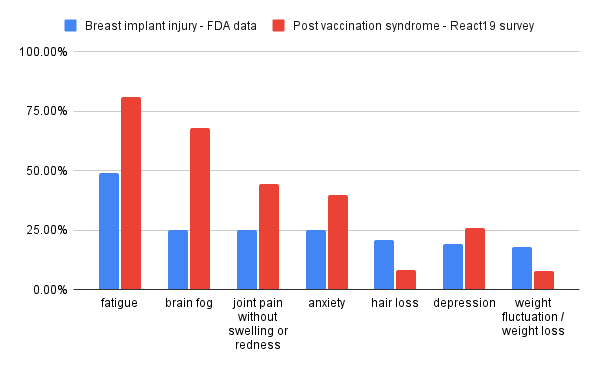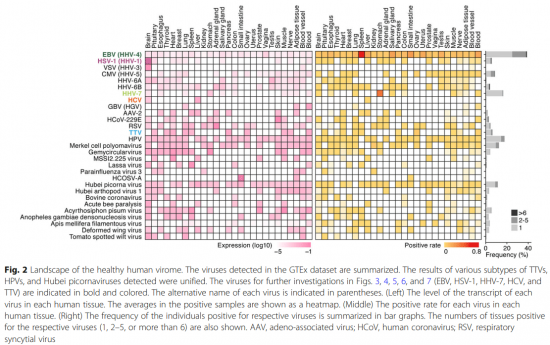Multiple persistent infections
Introduction
What's old is new again. Long haul syndromes (long COVID and vaccine injury) can be thought of as remixes of health problems that have previously existed. The syndromes heavily overlap with health conditions that have existed in the past.
ME/CFS versus post vaccination syndrome symptoms are compared below:
Data from:
- https://www.ncbi.nlm.nih.gov/labs/pmc/articles/PMC2429637/pdf/postmedj00163-0031.pdf
- https://www.react19.org/post/persistent-neurological-symptoms-patient-survey
Breast implant illness versus post vaccination symptoms are compared below:
Data from:
- https://www.fda.gov/medical-devices/breast-implants/medical-device-reports-systemic-symptoms-women-breast-implants
- https://www.react19.org/post/persistent-neurological-symptoms-patient-survey
The common denominator
One common thread that runs through long haul, ME/CFS, and breast implant illness (BII) are infectious diseases. Breast implants, while being inorganic and biologically inactive, turn out to be an excellent environment for bacteria. One observational study on BII patients found that BII patients were six times more likely to have culturable bacteria or fungi/yeast growing on their implants compared to healthy controls. Limitations on our current ability to detect microorganisms in biofilm structures may mean that bacterial colonies are more common than what the study detected (36% among BII patients).
ME/CFS is also a condition that has been linked to infectious diseases:
- Various infectious diseases: enteroviruses, herpesviruses including Epstein-Barr virus, Q fever, coxsackie b, and Ross River virus.
- Outbreaks
- Stress, e.g. from a divorce. Stress is thought to weaken the immune system.
- Trauma, e.g. a car accident, head injury, etc.
The data suggests that many different paths can lead to the body being unable to control persistent infections. The diversity of the bacteria, viruses, yeast, parasites, etc. that live inside humans would explain why symptoms vary so much from patient to patient.
The healthy human virome
Kumata and colleagues published the paper A tissue level atlas of the healthy human virome (https://doi.org/10.1186/s12915-020-00785-5). Their study examined the various viruses that live inside health human beings. One of their findings was that viruses don't always live in the same places in the body. One person might have Epstein-Barr virus (EBV) living only in their spleen while another person might have EBV living in multiple organs.
One phenomenon seen in a few long haulers are reactivated infections. Pre-existing viruses such as EBV, shingles / herpes zoster / varicella-zoster virus, etc. turn into more active infections and can be detected in the blood using commercially available tests. This suggests that the immune system is dysfunctional and unable to suppress persistent infections like a healthy immune system would.
The natural variations in the types of microorganisms living in a person and where they reside may explain why there are so many different symptoms and why they vary so much from person to person. A survey of long COVID patients published in The Lancet (https://doi.org/10.1016/j.eclinm.2021.101019) analyzed 203 different symptoms in long COVID sufferers.
Successive infection ("teamwork makes the dream work")
Microorganisms sometimes fight each other, e.g. by producing toxic poisons such as penicillin to kill off competing species fighting for the same resources. However, it is also possible for microorganisms to act synergistically in suppressing the immune system. All microorganisms living in humans tend to be able to do so because they have some mechanism for evading the immune system or suppressing it.
Proal and colleagues (https://doi.org/10.1097/BOR.0b013e32835cedbf) discuss how Epstein-Barr Virus, Borrelia (Lyme), CMV, and other microorganisms all interfere with the immune system by dysregulating the vitamin D receptor pathway. Their paper argues that a greater number of pathogens in the microbiome contributes to greater dysfunction in the immune system, eventually leading to chronic illness. Amy Proal explains these concepts in a Youtube video (https://youtu.be/7yjh04vMe1E).
Autoimmunity
Auto-antibodies are antibodies that engage in 'friendly fire' and stick to the host's proteins/antigens instead of the foreign antigens associated with pathogens. A study by Gerd Wallukat and his team on recovered COVID-19 patients (https://doi.org/10.1016/j.jtauto.2021.100100) found that all had between 2 and 7 different auto-antibodies of the GPCR-fAAB type (g-protein coupled receptor functionally active auto-antibodies). In healthy controls, such auto-antibodies are only found in a small percentage of people.
Proal and colleagues (https://doi.org/10.1097/BOR.0b013e32835cedbf) believe that such autoimmunity processes are being driven by molecular mimicry, a defense strategy where microorganisms evolve their external antigens to be extremely similar to the host's antigens. This strategy makes it difficult for the immune system to eradicate problematic microorganisms without also attacking host tissue.
While many autoimmune conditions are treated by suppressing the immune system and reducing the amount of 'friendly fire' from the immune system, such a strategy does not deal with the root cause: persistent infection. This may explain why immune suppression strategies (e.g. corticosteroids) fail in many patients. The patient's immune system is already unable to contain persistent infections and further suppression of the immune system only makes the underlying problem worse.
Current treatments
Unfortunately, it is difficult to treat persistent infections because the tests usually miss the infection and the treatments are often ineffective. Most microorganisms are extremely difficult or impossible to detect in the blood because they do not live in the blood and are quickly wiped out by the immune system if they make their way into the bloodstream. Research on the Lyme-causing bacteria Borrelia Burgdorferi by Monica Embers and her team has found that invasive, research-level tests are usually needed to detect persistent Borrelia infections (https://doi.org/10.3389/fmed.2021.666554). Her team also found that standard antibiotic treatments do not work since the Borrelia Burgdorferi bacteria form biofilm colonies that are incredibly resistant against the immune system and antibiotics.
Antibiotics
The 2014 ILADS treatment guidelines recommends the use of antibiotics in treating cases of chronic Lyme:
ILADS recommends antibiotic retreatment when a chronic Lyme infection is judged to be a possible cause of the ongoing manifestations and the patient has an impaired quality of life
Antivirals
Many viral diseases do not have a treatment. Some exceptions include:
- Herpes zoster (shingles): Acyclovir (Zovirax), Famciclovir, Valacyclovir (Valtrex)
- HIV: antiretrovirals
- Hepatitis C: Ledipasvir/Sofosbuvir (Harvoni), Simeprevir (Olysio), etc.
Interferon drugs
Interferons are molecules produced by the body's cells that "interfere" with the reproduction of viruses, hence the name interferon. There are many types of interferons. The pharmaceutical has developed interferons that are modified with polyethylene glycol (PEG); these are called pegylated interferons.
Interferons can be introduced into the body to help fight viral infections. However, interferon drugs alone are often not enough to cure hepatitis C. Both pegylated and non-pegylated interferons are used to treat both viral infections (e.g. hepatitis C) and autoimmune diseases (e.g. Rebif / interferon beta-1a is used to treat multiple sclerosis). Ironically, peginterferon alfa-2a seems to increase the chances of a new autoimmune disease developing in the patient.
Former Soviet Bloc countries (e.g. Russia, Ukraine) use interferon-inducing drugs such as tilerone to treat viral infections and multiple sclerosis, an autoimmune disease. Tilerone is low-cost and sold over the counter.
Potential / experimental treatments
Essential oils, carvacrol, and cinnamaldehyde
Zhang and colleagues studied the effect of various essential oils on Borrelia bacteria living in biofilms in their 'persister' form (https://doi.org/10.3389/fimmu.2021.700782). They found that antibiotics were mostly ineffective at stopping the bacteria and that certain essential oils were more effective than antibiotics at killing the bacteria. They also identified that the chemicals carvacrol and cinnamaldehyde, major components of effective essential oils, are potent chemicals against Borrelia persisters. Their findings have yet to be tested in human beings and these chemicals may not necessarily be effective in treating Borrelia infections in humans.
Carvacrol-containing supplements that are commercially available include oil of oregano and black seed oil (from the nigella sativa plant). One brand of black seed oil (Maju Superfoods) contains instructions that call for 4 teaspoons per day, which suggests that such a dosage may be safe for human consumption. 1-star reviews on Amazon and iHerb provide some information on what can go wrong with this supplement.
Cinnamaldehyde can be ingested through toothpicks infused with cinnamon oil. Sucking on such toothpicks is part of the local food practices in some areas of the United States. 1-star reviews on Amazon suggests that these toothpicks can cause mouth sores in some people.
Triple antibiotic combination (Daptomycin + Cefoperazone / Cefuroxime + Doxycycline)
Zhang and colleagues also studied the effect of antibiotic combinations on Borrelia persisters (https://doi.org/10.3389/fimmu.2021.700782). They found that a triple combination of antibiotics was effective in laboratory situations. This antibiotic combination has yet to be studied in humans.
Polyphenolic compound combination
Anna Goc and colleagues studied a combination of six plant-based compounds in both mice and humans (https://doi.org/10.1177/2040622320922005):
- Baicalein
- Luteolin
- Rosmarinic acid
- The fatty acids monolaurin and cis-2-decenoic acid
- Iodine/kelp
When trialed on human patients suffering from chronic Lyme, the results were:
- 3/17 symptom free
- 8/17 significant improvement
- 2/17 slight improvement
- 4/17 no improvement, minor side effects from treatment (that resolved after treatment was stopped)
There was no control group in the trial, so it is not entirely clear if the drug combination would have outperformed a placebo treatment. The compounds were purchased from specialty suppliers for higher purity than the same compounds available from mass-market consumer-grade supplements.
Olmesartan
Olmesartan is a repurposed drug being used experimentally to treat chronic illness. Proal and colleague's 2011 paper Immunostimulation in the era of the metagenome (https://doi.org/10.1038/cmi.2010.77) describes their experiences with using the drug to stimulate the immune system via the vitamin D receptor. Their paper describes both positive and negative results, sometimes after years of treatment.
Remdesivir
The World Health Organization does not recommend the use of remdesivir for the treatment of SARS-CoV-2 (the virus that causes COVID). However, a ME/CFS specialist named John Chia is trying the drug as a way to treat enterovirus infections (see this interview with Chia).
During the French 'DisCoVeRy' trial, 1-3 patient deaths were attributed to remdesivir. According to the paper on the clinical trial results:
Three deaths (acute respiratory distress syndrome, bacterial infection, and hepatorenal syndrome) were considered related to remdesivir by the investigators, but only one by the sponsor's safety team (hepatorenal syndrome).


